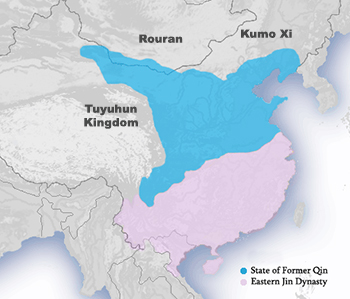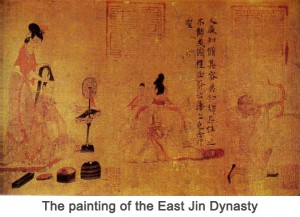(317–420)
 东晋In a brutal rebellion known as the Wu Hu Uprising (304-316), the Jin Dynasty (265-420) was overrun by the northern tribal peoples and the north of China was lost. In 311, the imperial capital of Luoyang was captured and the reigning Emperor Huai was executed. In a desperate attempt to keep power, Sima Ye was enthroned as Emperor Min at the secondary capital of Chang’an (modern-day Xi’an) but to no avail; rebel forces stormed Chang’an in 316 and forced him to surrender. In short, this was one very unlucky decade for the Sima family! They lost their stranglehold on the north of China and the Western Jin Dynasty (265–316) officially collapsed. The invasion of nomads in the north prompted droves of people to emigrate south of the Yangtze River, and it seems this was where the salvation of the Jin Dynasty lay.
东晋In a brutal rebellion known as the Wu Hu Uprising (304-316), the Jin Dynasty (265-420) was overrun by the northern tribal peoples and the north of China was lost. In 311, the imperial capital of Luoyang was captured and the reigning Emperor Huai was executed. In a desperate attempt to keep power, Sima Ye was enthroned as Emperor Min at the secondary capital of Chang’an (modern-day Xi’an) but to no avail; rebel forces stormed Chang’an in 316 and forced him to surrender. In short, this was one very unlucky decade for the Sima family! They lost their stranglehold on the north of China and the Western Jin Dynasty (265–316) officially collapsed. The invasion of nomads in the north prompted droves of people to emigrate south of the Yangtze River, and it seems this was where the salvation of the Jin Dynasty lay.
Upon hearing about the fall of Chang’an, Sima Rui founded the Eastern Jin Dynasty (317–420) with the southern city of Jiankang (modern-day Nanjing) as his capital and named himself Emperor Yuan of Jin. While the north of China was plunged into an unstable age known as the Sixteen Kingdoms Period (303-439), it seemed that things were finally looking up for the south. The influx of immigrants fleeing the northern nomads helped greatly, as they boosted the economy and development of southern China.
However, there was one major problem with this arrangement: the Eastern Jin Emperors had extremely limited power. They depended almost entirely on the support of local and refugee aristocratic families, who possessed significant military forces. After all, money doesn’t grow on trees, and nor do armies! Noble families that had emigrated from the central plains had the most power, but aboriginal southern clans presented a particular threat as their political desires were frequently at odds with those of the imperial court and the northern nobility. Like the Western Jin Dynasty, the central government was plagued by corruption, political intrigue, brutal rebellions, and petty rivalries between factions.
 Since the regime’s ultimate aim was to eventually recapture the lost northern territories, its success hinged on its military generals, who proved to be both its salvation and its undoing. An astute strategist named Huan Wen, for example, was responsible for resisting several northern attacks before reclaiming Sichuan province in 347. However, his new found political power also allowed him to depose the reigning emperor and enthrone a puppet ruler from the Sima family in his stead! Fortunately this unstable arrangement was fleeting, as the puppet ruler died not long thereafter and chose not to leave the throne to Huan Wen. Huan Wen intended to grab power for himself but, in a twist of fate, he died the following year.
Since the regime’s ultimate aim was to eventually recapture the lost northern territories, its success hinged on its military generals, who proved to be both its salvation and its undoing. An astute strategist named Huan Wen, for example, was responsible for resisting several northern attacks before reclaiming Sichuan province in 347. However, his new found political power also allowed him to depose the reigning emperor and enthrone a puppet ruler from the Sima family in his stead! Fortunately this unstable arrangement was fleeting, as the puppet ruler died not long thereafter and chose not to leave the throne to Huan Wen. Huan Wen intended to grab power for himself but, in a twist of fate, he died the following year.
By 376, the empire faced increasing danger from the Former Qin Dynasty[1] (351–394), which had successfully reunited the northern territories and represented a substantial military threat. In 383, this formidable force sent 300,000 troops to invade Jin’s territory, while the Jin could only muster up 80,000 soldiers to protect themselves. Severely outnumbered, it seemed the dynasty was doomed to fail. However, Fu Jian, the ruler of the Former Qin Dynasty, had foolishly entrusted a captive Jin general to persuade the Eastern Jin Dynasty to surrender.
When this general arrived back in Jin territory, he immediately told the leading Jin general all of the military information he had garnered while being held hostage in Former Qin territory. The Jin army used this information to their advantage and, thanks to a number of well-planned strategies, they were able to rout the Former Qin army in a crushing defeat during the epic Battle of Fei River. The Former Qin were so devastated by this battle that they eventually collapsed, and Chancellor Xie An was able to reclaim much of their territory north of the Huai River. This was a prosperous time for the Eastern Jin Dynasty, but not one that it would enjoy for long.
In 385, Emperor Xiaowu gave significant imperial power to his brother Sima Daozi and his nephew Sima Yuanxian. This proved to be a misguided move, as both relatives exploited the people and grossly misruled the country. While Emperor Xiaowu escaped the repercussions of his actions, he unwittingly passed them on to his unfortunate successor Emperor An! Disgruntled landowners began revolting against the government and, in 398, a rebellious branch of the army led by Sun En conquered the area surrounding the imperial capital. This greatly restricted the power of the central government and, from then on, the dynasty was in decline.
Huan Xuan, son of Huan Wen, seized this opportunity by capturing the capital and dethroning Emperor An, declaring himself emperor instead. Like fighting fire with fire, the only way to defeat these rebels was with an even larger band of rebels! In 406, another rebel army led by Liu Yu defeated Huan Xuan and reinstated Emperor An. Although it seemed as though the regime had resumed as normal, Liu Yu held all of the power and was secretly plotting to usurp the throne. He was a brilliant strategist and, from 415 through till 417, he launched a series of military expeditions that successfully expanded the Jin territory to the northwest, allowing the dynasty to regain control of Central Asian trade routes.
In 419, he wielded such political power that he was able to have Emperor An strangled and placed the pliable Sima Dewen or Emperor Gong on the throne in his stead. With a large empire thus established and with the weakened court ripe for military coup, in 420 he forced Emperor Gong to abdicate and established the Liu Song Dynasty (420–479), officially ending the Eastern Jin Dynasty. This was the first of the Southern Dynasties and marked the beginning of yet another turbulent era in Chinese history known as the Northern and Southern Dynasties Period (420-589). Under Liu Yu’s rule, southern China would enter a golden age that was, like so many others, tragically short-lived.
[1] Former Qin Dynasty: This is not to be confused with the Qin Dynasty (221-206 BC). It was named the “Former Qin” because it initially ruled an area known as the State of Qin and it came before the Later Qin Dynasty (384-417).